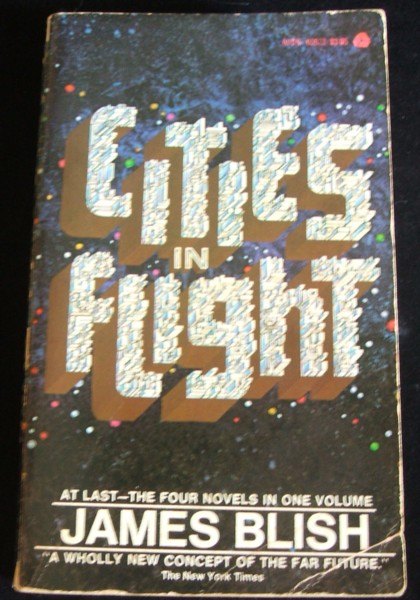Cities in Flight
containing the 'Okie' novels
-They Shall Have Stars
-A Life for the Stars
-Earthman, Come Home
-The Triumph of Time
James Blish
Avon 1982
ISBN 0 380 00998 6
 A four volume cycle, originally published between 1957 and 1962 with small sections of ‘Earthman, Come Home’ published between 1950 and 1953. I first read these individual books during the late 1970’s and found a copy of the omnibus publication in 1991.
A four volume cycle, originally published between 1957 and 1962 with small sections of ‘Earthman, Come Home’ published between 1950 and 1953. I first read these individual books during the late 1970’s and found a copy of the omnibus publication in 1991.
Two technologies underpin these stories – the discovery of the anti-aging drug Ascomycin, and the discovery of the anti-gravity drive known as the “spindizzy”. In the latter case, the larger the mass the “spindizzy” field has to work on, the more efficient it becomes until, ultimately, factory complexes and entire cities leave the Earth to wander the stars as itinerant labour and heavy construction specialists.
The first novel in the cycle –the dystopian “They Shall Have Stars”- is mainly concerned with the development of these two technologies. The German historian Oswald Spengler, and his theories of cyclic history heavily influenced Blish. One aspect of Spengler’s theories being that two cultures in conflict will ultimately come to resemble each other, and this is the situation in “They Shall Have Stars” as “the West” becomes as authoritarian as the “Communist” world.
It is interesting that this novel, written in the period of McCarthyism and the height of the Cold War, has some political resonance even today with the ‘War on Terror’.
The second and third novels – “A Life for the Stars” and “Earthman, Come Home” – are more conventional science fiction adventure stories. “A Life for the Stars” is a coming of age story of a young man swept up by one of the last cites to leave Earth. He eventually ends up in New York, another flying city, where, against the odds, he finds a place to call home. “Earthman, Come Home” is a series of adventures set in the flying city of New York (sections of this novel were published in various magazines between 1950 and 1953) as it struggles to stay solvent and working in an increasingly hostile galaxy. Greatest moment? If a spindizzy field can move a city-sized mass at a speed related to that mass, what can you do with sufficient spindizzy engines and a planetary mass?
The last novel in the series – “The Triumph of Time”, published in the UK as “A Clash of Cymbals” – is the most difficult of the stories. It is an amalgam of the philosophising and ‘big thoughts’ of “They Shall Have Stars” with leavenings of interstellar adventures last seen in “Earthman, Come Home”, but doesn’t quite work in either genre (unless I’ve missed something crucial).
I enjoyed re-reading these stories again, and, apart from the use of slide-rules by the engineer characters, feel that the technology, as described, is sufficiently vague not to have aged too badly. I understand that the maths equations that Blish goes into in some depth to establish his “spindizzy” technology, have now proved to mean something else, which is a bit of a disappointment as there is something inherently romantic about the thought of great flying cities.
There is an article at Wikipedia that discusses Blish’s life and some of the themes and influences both on him, and, through his novels, on others. A Google for James Blish throws up some interesting results, including the factoid that, in the City Fathers, Blish was the first writer to suggest the advantages of parallel computer processing for error checking and self-correcting.
‘Cities in Flight’ is Number 3 on the Orion Books SF Masterworks List